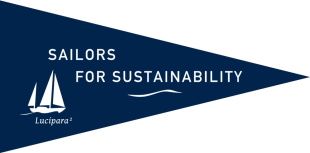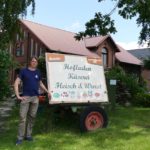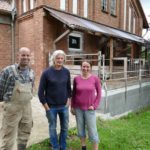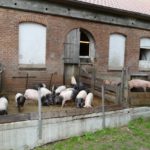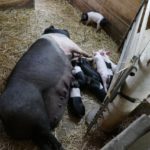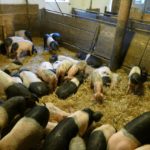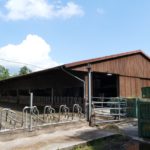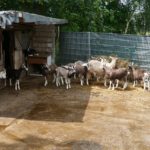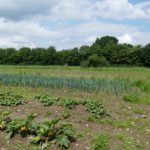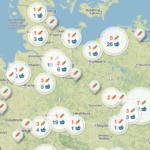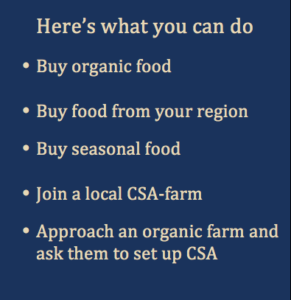Community Supported Agriculture (DEU)
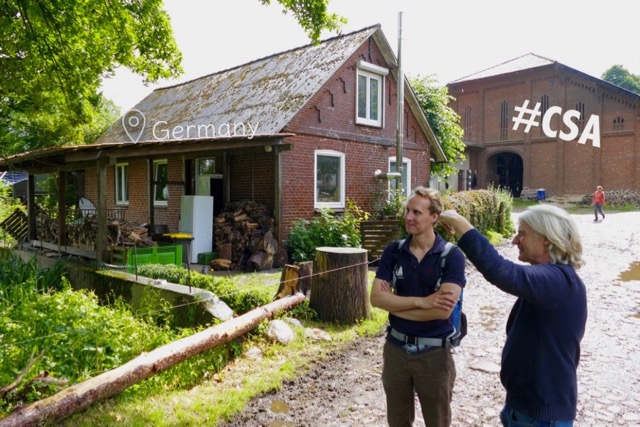
The Kattendorfer Hof produces organic food and works on the basis of Community Supported Agriculture.
Contributes to achieving the following UN Sustainable Development Goals:
For the first time on this trip we leave the coast. In Kiel we board a train that takes us through the countryside to a small town in the centre of Schleswig-Holstein. From here it’s a five-kilometre walk to Kattendorf, which we quite enjoy on this beautiful summer’s day.
At the village, a large sign beckons the presence of the Kattendorfer Hof. It is Europe’s largest farm that works on the basis of Community Supported Agriculture (CSA). When we approach the barn farmer Mathias von Mirndorf welcomes us. He is also a sailor and responded enthusiastically to our request to visit his farm.
The Case for Sustainable Food Production
Our research on nutrition suggests that there are some fundamental sustainability challenges related to a model based on large-scale industrial farming. It is driven by continuous pressure to achieve higher yields at lower prices and dependent on fossil-based – and therefore finite – fertilizers, pesticides and transportation fuels. Furthermore, intensive use of soils leads to serious problems of erosion, pollution, and biodiversity loss. There are also significant issues with animal welfare and human health. And last but not least, industrial agriculture – especially meat production – is a big contributor to climate change.
In our view, sustainable food production means that we produce enough food to feed the world a healthy and affordable diet, while preserving the planet’s ecosystems to meet the nutritional requirements of current and future generations. Soil and water should not be depleted or contaminated; fertilizers and pesticides based on finite resources should not be used.
Organic food production tackles some of these issues by using natural fertilizers and pesticides. It encourages biodiversity and healthy soils. The yield of total crops per m2 is potentially higher compared to industrial agriculture, which is good news in the light of agricultural land use. A big challenge is the higher cost of production, which is mainly related to a more labour-intense production process.
The Kattendorfer Hof proves that it is possible to solve the cost issue by changing the business model. It produces organic food and distributes its produce directly to its members – consumers like you and me – who also co-finance the farm. This principle is known as Community Supported Agriculture (CSA).
A Farm Straight out of a Children’s Book
Mathias takes us on a tour of the farm. A spacious house serves as the central building where we later have lunch with Mathias, his family and staff. Next to it are a large barn, where a cow is about to give birth, and stables for the pigs and goats. Dotted over the estate are cottages that house some of the farm’s employees. The fields with grass, clover, spelt, potatoes, vegetables and fruit are around it. The farms operates according to the strictest norms for organic production (Demeter) and the nutrient cycle is balanced: the animals live of the proceeds of the land (grass, clover, hay) and the leftovers of the cheese production, while the animal manure in turn provides enough fertilizer to maintain a fertile soil.
The animals are an integral part of the farm, as we notice when we get a comprehensive explanation about the pigs. They are a rare breed, which Mathias helps to save from extinction. They are cared for with love and have plenty of space to run around and play. A little later we see how people are emotionally attached to the animals. A cow has an infection and cannot be saved. It touches everyone’s hearts and some are in tears. The diversity of crops, animals, and family involvement reminds us of the feel-good farm pictures that are typical in children’s books, but have almost entirely disappeared in the real world.
Sharing the Harvest as Funding Model
Mathias explains that farmers have the choice to exploit either themselves or nature. That is, if you want to make farming economically viable. You’re dependent on fluctuating market prices, over which you have no control. It is not exactly an ideal or attractive business model, so Mathias looked for and found an alternative in CSA. It has nature and people at its core and connects directly with consumers. Not in the production, because Mathias could not expect that from city dwellers from nearby Hamburg, but in the distribution of the harvest, and thus the financing of the farm.
This is how it works. The harvest is divided into 450 parts. One part consists of the quantity of food that an adult approximately needs. For one membership part a customer receives on average the following harvest share per week: lettuce and herbs, 1.5-3 kg of vegetables, 1 kg of potatoes, 0.7 kg meat and milk products from 7.5 litres of milk. The exact amounts depend on the harvest and the season. Every week the farm distributes the harvest parts to its members.
Consumers can buy an annual membership for 1/2 or more harvest parts. One harvest part costs €250 per month. For those who want to eat even more sustainably, there is a (cheaper) vegetarian option. The membership fees that the Kattendorfer Hof receives cover most of its expenses.
The price of the membership seems quite reasonable to us, especially since distribution is included. The customers of the Kattendorfer Hof are organised into cooperatives of eight to thirty members. Each cooperative decides where the harvest shares are delivered, such as in someone’s home or in the basement of an apartment building. After delivery, the members divide the delivery for the their cooperative among themselves. In this way it is economically feasible to skip the entire wholesale and retail chain and deliver directly to consumers. The margin that is saved can be spent on labour-intense, sustainable production.
Consumers Get Involved
The system reminds us a bit of the weekly “vegetable box” that you can get from organic grocery stores in the Netherlands, but CSA works differently. Sharing the harvest is at the core of CSA. This means that the farmer is assured of customers. He has a fixed income throughout the year and is therefore not dependent on world prices or the pricing demands of supermarkets. That provides more financial leeway and also makes planning ahead easier.
Each year, members of the Kattendorfer Hof can review the budget, which forms the basis for the price of a harvest share. They can see exactly where their contributions are spent. They also get the opportunity to ask questions, discuss and vote. If they feel like it, members may also assist Mathias and his team with the harvest, such as on special days organized by the farm around the strawberry, onion and carrot harvests. This involvement increases the bond with and commitment to the farm.
Regional Actions to Tackle the Global Crisis
It does not surprise us that six hundred households make the Kattendorfer Hof a success. Still, it took some time before CSA caught on in Hamburg and surroundings. It was hard work, Mathias explains. Good communication was important, because CSA was new and different. As the harvest fluctuates, it is possible that members receive a lot of vegetables in one week, and the next week they receive less. Therefore, all participants receive a weekly newsletter telling them what they can expect. And it works; members accept the fluctuations.
There are CSAs all over the world and the number keeps growing. The International Network for CSA maintains a database of CSAs worldwide. And consumers nowadays even get organised and approach organic farms to ask them to set up CSA.
A Local Solution for a Global Crisis
In Mathias’s words: “Community Supported Agriculture can be a solution for the global agricultural crisis. Everybody needs food on a daily basis. It is important that food is produced regionally and sustainably to save on raw materials and energy. In my experience that can only be achieved if producers and consumers are connected to each other and have an honest relationship. Act regionally to make a difference globally.”
We take Mathias’s message back to the boat. Mathias and his team have inspired us to look for regional, organic food wherever we go. Scandinavian cuisine awaits us the next months!
Related Sustainable Solutions

Enviroschools (NZL)
What does it take to integrate sustainability in education? New Zealand’s Enviroschools are leading the way.

Buy Local (PYF)
In Tahiti we discover markets with fresh fruit and vegetables from the island. We learn that buying local has various benefits for the community.

Self-Sufficient Living (PYF)
On the island of Taravai, we meet a self-sufficient family. Their lifestyle is not only more resilient, but also provides sustainability benefits.

Community-Based Tourism (PER)
Community-based tourism, with slow travel and homestays at its core, makes for an authentic and more sustainable travel experience.

Sustainable Schools (URY)
The buildings and teachings at these schools are textbook examples of sustainability.

Ecovillage Findhorn (GBR)
Spirituality plays a big part at Findhorn Ecovillage, which is based on love for nature and each other.
